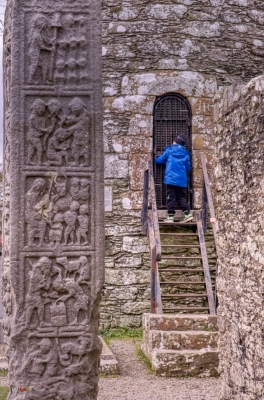
Monasteboice: Round Tower and Tall Cross
I suspected that this visitor from Scandanavia wasn't the first Viking to climb the steps to the Round Tower. He was unable to gain access; perhaps he'll return when he's older with a gang. Some say that it was the Viking raids that created a need for more permanent stone crosses to resist theft and vandalism. An un-stolen cross can be seen on the left foreground. This includes five panels from the west face of Tall Cross. The top panel illustrates Samson knocking over a temple. Below that, Goliath's head is held by David and on the right, Samuel is anointing him. The middle panel is thought to be Moses smiting the rock. And below that comes the sacrifice of Isaac and finally, at the bottom of this photograph, David is portrayed slaying a lion.
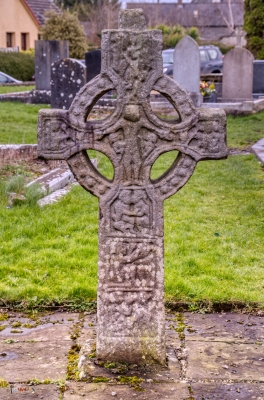
Duleek High Cross
The Celtic motifs on the Duleek Cross are world renowned if only because they have inspired generations of artists and jewellers. There's quite a mix of biblical themes intermixed with the Celtic ornamentation that also embellishes manuscripts like the Book of Kells.
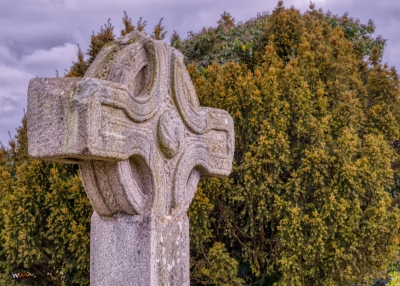
Dromiskin High Cross
This is the western aspect of the head of a granite cross from the tenth century, its remains resurrected and emplaced on a bespoke granite base and shaft in 1918. The site seems to have been monastic since the fifth century.
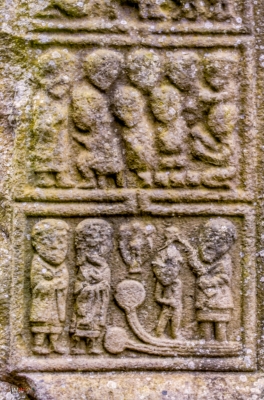
Kells: Broken Cross
The lower panel, the baptism of Christ is doing better than the Wedding Feast at Cana. Perhaps there's a moral in that comparison?
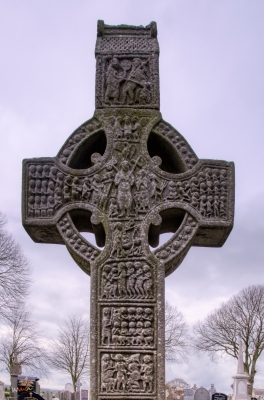
Monasterboice: Muiredach's Cross: East Face
Is this the best cross in Ireland? The detail is fantastic, the preservation perhaps even more amazing. A great way for the elite to conveys stories to a largely illiterate population. From the shingled roof on the finial down the to the dove above Christ and on down to the adoration of four Magi and below, the messages remain very clear. Tough sandstone, I wondered about the source and if it was quarried or is a worked glacial dropstone.

Monasterboice: Muiredach's Cross
It seems that the Monasterboice crosses were carved between 850 and 920CE.
The inscription "OR DO MUIREDACH LASNDERNAD IN CHROS" invokes us to pray for Muiredach. Either Abbot Muiredach (d. 923CE) or King Muiredach who died some 50 years earlier, whichever one most liked watching cats playing with kittens and killing birds?
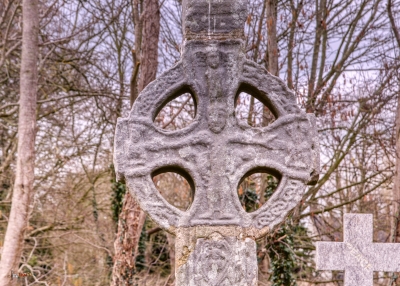
Termonfeckin High Cross
The fading crucifixion scene faces east which suggets that this cross, obviously and crudely repaired, was re-erected back to front. Spare a thought for Ukraine: the digital graffiti I put on the cross in the chapbook is an Easter Egg, intended to remind you of what the defenders of Snake Island said to the Russian warship.
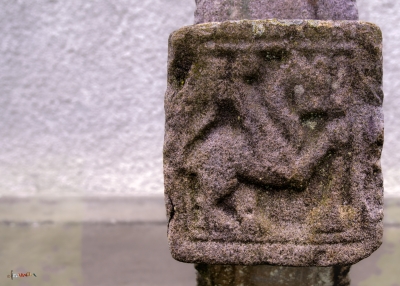
Duleek High Cross
The north edge of the cross depicts what appears to be a horse and rider. The sandstone is showing its age, fading slowly but surely.
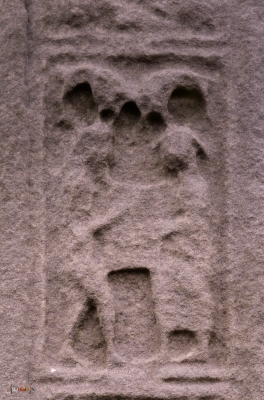
Monasterboice
Faded with erosive time, this icon isn't easy to decipher. Sandstones are some of the most variable rocks and while many of the other examples are surviving well, perhaps this was less indurated in the first place. Easier to sculpt, to carve but not hard enough to survive more than a millennium.
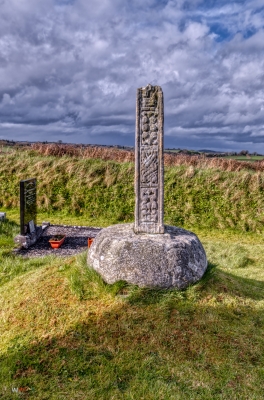
Killary Cross: South Face
The sun briefly picked out the finely carved panels with their collection of patterns. This is the south side of the topless shaft made from sandstone.
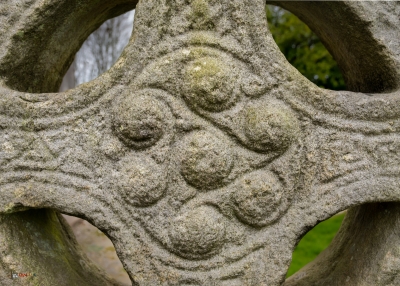
Duleek High Cross
Some say that these seven raised spirals represent the visible planets orbiting the sun. It would be June 22, 1633 before Galileo was found guilty of heresy for defending “On the Revolutions of the Heavenly Spheres" published by Copernicus in 1543.
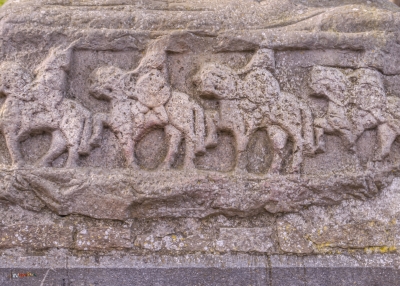
Kells: Market Cross
Four horsemen adorn the base of the east face. Their shields brought crusaders to mind but they hadn't appeared yet.
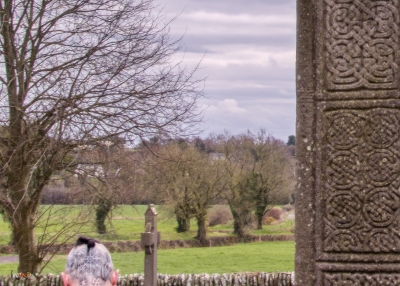
Monasterboice: Muiredach's Cross
All I could see was the passing tattoo.
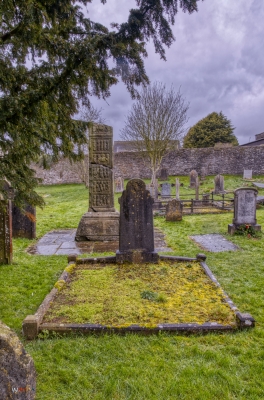
Kells: Broken Cross
Considering that the head is missing and the shaft very damaged, the North or Broken Cross has some remarkably well preserved scenes from the Old Testament on the east face. But on closer inspection, significant decay is evident. I wondered about frost since frost is one of the major forces in mechanical erosion.
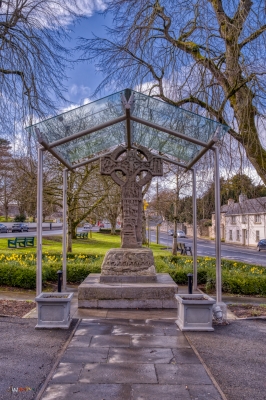
Kells: Market Cross
The Market Cross has been moved several times, most recently after it was hit by a bus when in the centre of town. It sits under a glass canopy outside the old courthouse, now the tourist office. This may preserve it from damage and decay but the microclimate seems to favour lichen growth.
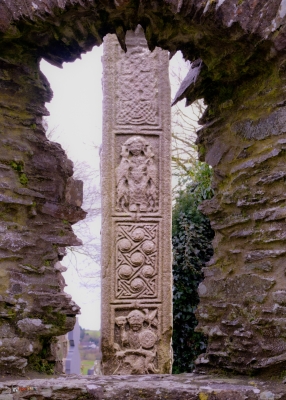
Monasterboice: Tall Cross: North Face
While the other three faces are decorated with biblical scenes, this panels on this are less clear though no less ornate. Perhaps it's time for someone to tell me what we're looking at?
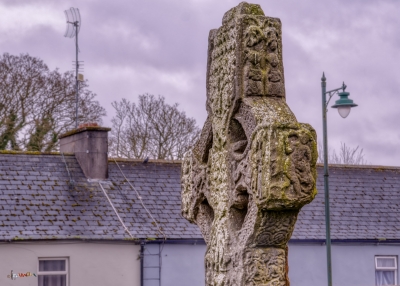
Kells: South Cross
This may be the oldest of the crosses in Kells given that there are no bordered panels. Some consider it was created during a transitional period between the flowing Celtic and iconic Christian ornamental styles. There's an inscription that reads PATRICII ET COLUMBE CRUX which gives it a second name, the Cross of St Patrick and St Columba. It's profusely decorated on every face with scenes from the Old and New Testament intermixed with Celtic knots and spirals. It stands overlooking a terrace of homes in a very urban setting yet the site itself is wonderfully tranquil.
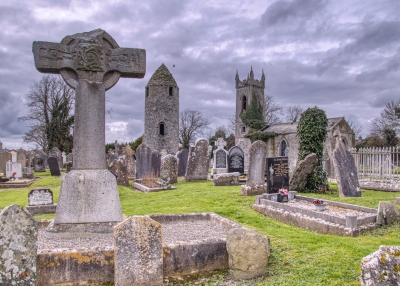
Dromiskin High Cross
The east side of the cross has strange (to me) motifs of a headless torso riding a horse and an uncoiling dragon on the boss. I wondered what the finial would have looked like and where it might have gone.
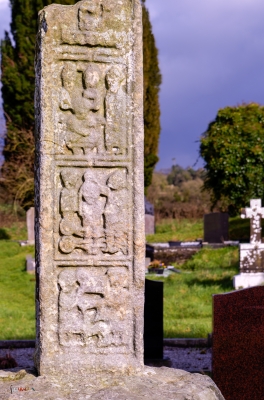
Killary Cross
The west face was lit between rain showers to show three scenes from the New Testament. I'm sure the archeologists are right and I can see that the middle panel could be a baptism, the Baptism of Christ, said to include the river Jordan on the bottom left. But the Adoration of the Magi above it and the Annunciation to the Shepherds below were beyond my comprehension.
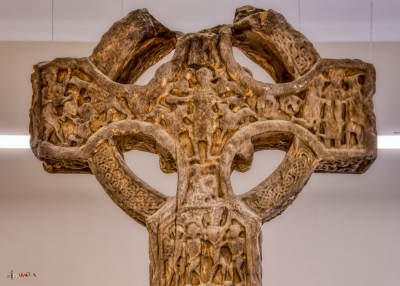
Kells: Market Cross Copy
A tourist guide liked my story of dissolution and I was brought into the back room where this copy is stored. We wondered if I could see the erosion outside by comparison to the twenty year old copy. The answer was no, there was too much lichen growth on the original outside and besides, the light was poor. I have heard that some plaster casts are held in American universities, casts made when Ireland was part of the Victorian Empire. A useful tool for differential measures of decay over the last century.
All images © Simon Robinson 2023
